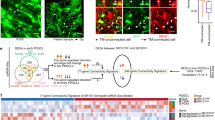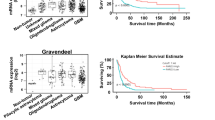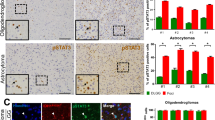Abstract
Connexins (Cxs), the gap junction proteins, have been found to be downregulated in many types of cancers including gliomas. By restoring gap junctional communication in cancer cell models, the neoplastic phenotype can be reversed, suggesting Cxs are tumor suppressors. Pannexin2 (Panx2) is a member of the novel gap junction protein family, Panxs, and it has been proposed as a brain-specific protein. Recently, gene array analysis showed an overall reduction of Panx2 in gliomas, and a direct correlation was observed between Panx2 expression and post-diagnosis survival in patients. In this study, we explored the potential inverse correlation between Panx2 and glioma oncogenicity. A decrease or absence of Panx2 expression in a panel of human glioma cell lines was found, whereas an appreciable amount of Panx2 was detected in both human brain and astrocytes. Stable Panx2 expression revealed a flattened morphology and increased cell–cell contacts in rat C6 glioma cells similar to Panx1. However, in contrast to Panx1 and Panx3, Panx2 was predominately detected in the cytoplasm in vesicle-like patterns but not at the plasma membrane. Coexpression of Panx2 and Panx1 did not show colocalization of both Panxs. Strikingly, restoration of Panx2 expression significantly reduced in vitro oncogenicity parameters, including monolayer saturation density and anchorage-independent growth, as well as in vivo tumor growth. This study suggests a role of aberrant Panx2 expression during gliomagenesis, and that Panx2 independently functions as a negative growth regulator without Panx1.
This is a preview of subscription content, access via your institution
Access options
Subscribe to this journal
Receive 50 print issues and online access
$259.00 per year
only $5.18 per issue
Buy this article
- Purchase on Springer Link
- Instant access to full article PDF
Prices may be subject to local taxes which are calculated during checkout




Similar content being viewed by others
References
Baranova A, Ivanov D, Petrash N, Pestova A, Skoblov M, Kelmanson I et al. (2004). The mammalian pannexin family is homologous to the invertebrate innexin gap junction proteins. Genomics 83: 706–716.
Barth RF . (1998). Rat brain tumor models in experimental neuro-oncology: the 9L, C6, T9, F98, RG2 (D74), RT-2 and CNS-1 gliomas. J Neurooncol 36: 91–102.
Berthoud VM, Minogue PJ, Laing JG, Beyer EC . (2004). Pathways for degradation of connexins and gap junctions. Cardiovasc Res 62: 256–267.
Boengler K, Dodoni G, Rodriguez-Sinovas A, Cabestrero A, Ruiz-Meana M, Gres P et al. (2005). Connexin 43 in cardiomyocyte mitochondria and its increase by ischemic preconditioning. Cardiovasc Res 67: 234–244.
Bruzzone R, Barbe MT, Jakob NJ, Monyer H . (2005). Pharmacological properties of homomeric and heteromeric pannexin hemichannels expressed in Xenopus oocytes. J Neurochem 92: 1033–1043.
Bruzzone R, Hormuzdi SG, Barbe MT, Herb A, Monyer H . (2003). Pannexins, a family of gap junction proteins expressed in brain. Proc Natl Acad Sci USA 100: 13644–13649.
Chiarugi P, Giannoni E . (2008). Anoikis: a necessary death program for anchorage-dependent cells. Biochem Pharmacol 76: 1352–1364.
D'Abaco GM, Kaye AH . (2007). Integrin-linked kinase: a potential therapeutic target for the treatment of glioma. J Clin Neurosci 14: 1041–1048.
Das SJ, Das S, Koval M . (2005). Regulation of connexin43 oligomerization is saturable. Cell Commun Adhes 12: 237–247.
Hu J, Jiang CC, Ng HK, Pang JC, Tong CY, Chen SQ . (2004). A genome-wide allelotype study of primary and corresponding recurrent glioblastoma multiforme in one patient. Chin Med J (Engl) 117: 456–458.
Huang YJ, Maruyama Y, Dvoryanchikov G, Pereira E, Chaudhari N, Roper SD . (2007). The role of pannexin 1 hemichannels in ATP release and cell-cell communication in mouse taste buds. Proc Natl Acad Sci USA 104: 6436–6441.
Ino Y, Silver JS, Blazejewski L, Nishikawa R, Matsutani M, von Deimling A et al. (1999). Common regions of deletion on chromosome 22q12.3-q13.1 and 22q13.2 in human astrocytomas appear related to malignancy grade. J Neuropathol Exp Neurol 58: 881–885.
Lai CP, Bechberger JF, Thompson RJ, MacVicar BA, Bruzzone R, Naus CC . (2007). Tumor-suppressive effects of pannexin 1 in C6 glioma cells. Cancer Res 67: 1545–1554.
Laing JG, Tadros PN, Westphale EM, Beyer EC . (1997). Degradation of connexin43 gap junctions involves both the proteasome and the lysosome. Exp Cell Res 236: 482–492.
Lee AS . (2005). The ER chaperone and signaling regulator GRP78/BiP as a monitor of endoplasmic reticulum stress. Methods 35: 373–381.
Li H, Brodsky S, Kumari S, Valiunas V, Brink P, Kaide J et al. (2002). Paradoxical overexpression and translocation of connexin43 in homocysteine-treated endothelial cells. Am J Physiol Heart Circ Physiol 282: H2124–H2133.
Litvin O, Tiunova A, Connell-Alberts Y, Panchin Y, Baranova A . (2006). What is hidden in the pannexin treasure trove: the sneak peek and the guesswork. J Cell Mol Med 10: 613–634.
Locovei S, Bao L, Dahl G . (2006). Pannexin 1 in erythrocytes: function without a gap. Proc Natl Acad Sci USA 103: 7655–7659.
Loewenstein WR . (1987). The cell-to-cell channel of gap junctions. Cell 48: 725–726.
Mesnil M . (2002). Connexins and cancer. Biol Cell 94: 493–500.
Naus CC . (2002). Gap junctions and tumour progression. Can J Physiol Pharmacol 80: 136–141.
Naus CC, Bechberger JF, Caveney S, Wilson JX . (1991). Expression of gap junction genes in astrocytes and C6 glioma cells. Neurosci Lett 126: 33–36.
Naus CC, Goldberg GS, Sin WC . (2005). Connexins in growth control and cancer. In: Winterhager E (ed). Gap Junctions in Development and Disease. Springer-Verlag: Heidelberg, pp. 253–273.
Oskam NT, Bijleveld EH, Hulsebos TJ . (2000). A region of common deletion in 22q13.3 in human glioma associated with astrocytoma progression. Int J Cancer 85: 336–339.
Pelegrin P, Surprenant A . (2006). Pannexin-1 mediates large pore formation and interleukin-1beta release by the ATP-gated P2X7 receptor. EMBO J 25: 5071–5082.
Pelegrin P, Surprenant A . (2007). Pannexin-1 couples to maitotoxin- and nigericin-induced interleukin-1beta release through a dye uptake-independent pathway. J Biol Chem 282: 2386–2394.
Qin H, Shao Q, Igdoura SA, Alaoui-Jamali MA, Laird DW . (2003). Lysosomal and proteasomal degradation play distinct roles in the life cycle of Cx43 in gap junctional intercellular communication-deficient and -competent breast tumor cells. J Biol Chem 278: 30005–30014.
Ray A, Zoidl G, Wahle P, Dermietzel R . (2006). Pannexin expression in the cerebellum. Cerebellum 5: 189–192.
Romanov RA, Rogachevskaja OA, Bystrova MF, Jiang P, Margolskee RF, Kolesnikov SS . (2007). Afferent neurotransmission mediated by hemichannels in mammalian taste cells. EMBO J 26: 657–667.
Schulz R, Boengler K, Totzeck A, Luo Y, Garcia-Dorado D, Heusch G . (2007). Connexin 43 in ischemic pre- and postconditioning. Heart Fail Rev 12: 261–266.
Skerrett IM, Di WL, Kasperek EM, Kelsell DP, Nicholson BJ . (2004). Aberrant gating, but a normal expression pattern, underlies the recessive phenotype of the deafness mutant Connexin26M34T. FASEB J 18: 860–862.
Thomas T, Jordan K, Simek J, Shao Q, Jedeszko C, Walton P et al. (2005). Mechanisms of Cx43 and Cx26 transport to the plasma membrane and gap junction regeneration. J Cell Sci 118: 4451–4462.
Thompson RJ, Zhou N, MacVicar BA . (2006). Ischemia opens neuronal gap junction hemichannels. Science 312: 924–927.
Trosko JE, Ruch RJ . (2002). Gap junctions as targets for cancer chemoprevention and chemotherapy. Curr Drug Targets 3: 465–482.
Vogt A, Hormuzdi SG, Monyer H . (2005). Pannexin1 and Pannexin2 expression in the developing and mature rat brain. Brain Res Mol Brain Res 141: 113–120.
Wang XH, Streeter M, Liu YP, Zhao HB . (2008). Identification and characterization of pannexin expression in the mammalian cochlea. J Comp Neurol 512: 336–346.
Zappala A, Li VG, Serapide MF, Pellitteri R, Falchi M, La Delia F et al. (2007). Expression of pannexin2 protein in healthy and ischemized brain of adult rats. Neuroscience 148: 653–667.
Zheng X, Shen G, Yang X, Liu W . (2007). Most C6 cells are cancer stem cells: evidence from clonal and population analyses. Cancer Res 67: 3691–3697.
Acknowledgements
The research was supported by the Canadian Institutes of Health Research. The authors thank Dr WC Sin for the critical review of the paper, Dr L Matsuuchi for the insightful data discussions, as well as Lynne Bechberger for proofreading the paper. CCN is a recipient of a Canada Research Chair.
Author information
Authors and Affiliations
Corresponding author
Additional information
Supplementary Information accompanies the paper on the Oncogene website (http://www.nature.com/onc)
Rights and permissions
About this article
Cite this article
Lai, C., Bechberger, J. & Naus, C. Pannexin2 as a novel growth regulator in C6 glioma cells. Oncogene 28, 4402–4408 (2009). https://doi.org/10.1038/onc.2009.283
Received:
Revised:
Accepted:
Published:
Issue Date:
DOI: https://doi.org/10.1038/onc.2009.283
Keywords
This article is cited by
-
Roles of ferroptosis in urologic malignancies
Cancer Cell International (2021)
-
Connexin and pannexin channels in cancer
BMC Cell Biology (2016)
-
Connexins, Pannexins, and Their Channels in Fibroproliferative Diseases
The Journal of Membrane Biology (2016)
-
Connexins: junctional and non-junctional modulators of proliferation
Cell and Tissue Research (2015)
-
The lung communication network
Cellular and Molecular Life Sciences (2015)



